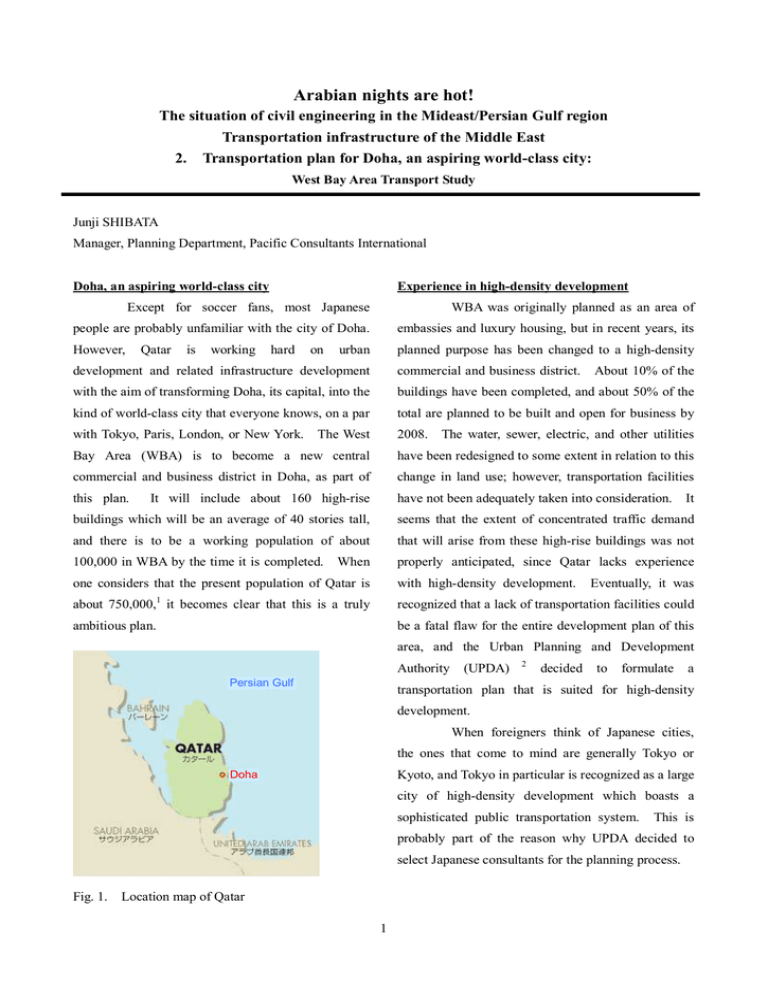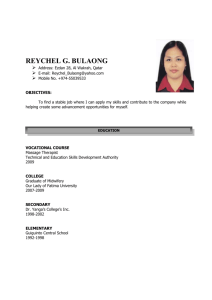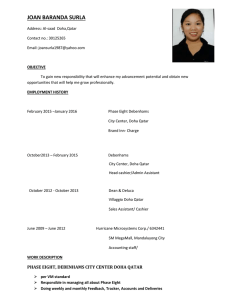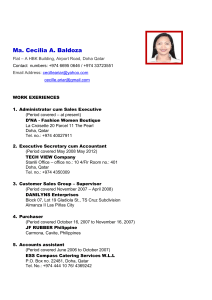Arabian nights are hot!
advertisement

Arabian nights are hot! The situation of civil engineering in the Mideast/Persian Gulf region Transportation infrastructure of the Middle East 2. Transportation plan for Doha, an aspiring world-class city: West Bay Area Transport Study Junji SHIBATA Manager, Planning Department, Pacific Consultants International Doha, an aspiring world-class city Experience in high-density development Except for soccer fans, most Japanese WBA was originally planned as an area of people are probably unfamiliar with the city of Doha. embassies and luxury housing, but in recent years, its However, planned purpose has been changed to a high-density Qatar is working hard on urban development and related infrastructure development commercial and business district. with the aim of transforming Doha, its capital, into the buildings have been completed, and about 50% of the kind of world-class city that everyone knows, on a par total are planned to be built and open for business by with Tokyo, Paris, London, or New York. 2008. The West About 10% of the The water, sewer, electric, and other utilities Bay Area (WBA) is to become a new central have been redesigned to some extent in relation to this commercial and business district in Doha, as part of change in land use; however, transportation facilities this plan. have not been adequately taken into consideration. It will include about 160 high-rise It buildings which will be an average of 40 stories tall, seems that the extent of concentrated traffic demand and there is to be a working population of about that will arise from these high-rise buildings was not 100,000 in WBA by the time it is completed. properly anticipated, since Qatar lacks experience When one considers that the present population of Qatar is with high-density development. 1 Eventually, it was about 750,000, it becomes clear that this is a truly recognized that a lack of transportation facilities could ambitious plan. be a fatal flaw for the entire development plan of this area, and the Urban Planning and Development Authority Persian Gulf (UPDA) 2 decided to formulate a transportation plan that is suited for high-density development. When foreigners think of Japanese cities, the ones that come to mind are generally Tokyo or Kyoto, and Tokyo in particular is recognized as a large Doha city of high-density development which boasts a sophisticated public transportation system. This is probably part of the reason why UPDA decided to select Japanese consultants for the planning process. Fig. 1. Location map of Qatar 1 of minimizing travel distance within the limited development area. Therefore, we have proposed changing from rotary intersections to at-grade intersections, and incorporating signalized intersections and area traffic control systems (ATC) on main roads. Traffic flow simulations were an effective way to obtain acceptance of this idea, which Photograph 1. Looking toward WBA from the present city center. was an unfamiliar concept. We have also proposed changes in detailed aspects, such as revising the 3.65-meter road width recommended in the Qatar Highway Design Manual to the standard road width in Japanese cities, which is 3.25 meters, in order to increase the number of lanes while also providing an effective sidewalk width. On the medium to long term, the introduction of mass transit facilities will be unavoidable. High density development is only Fig. 2. Artist's rendering of the future WBA cityscape planned for this area, but along the coast, work has Thoughts of Japanese transportation planners urban construction, and a new airport. regarding Doha a light rail service would be very effective. already begun on development of large-scale housing, In the future, With the existing road capacity, severe Therefore, we have proposed setting space aside in congestion is expected to occur as early as 2008. advance for the sake of bus rapid transit (BRT), which There is an urgent need to improve the traffic capacity is capable of flexible route selection, and for light rail of roads and intersections on the short term. transit (LRT) in the future. However, the government has specified that only the space within the right-of-way (ROW) of roads may be used for road improvement, and this limitation has led to a need for various innovations. In Qatar (right-side traffic flow), there is a preference for right-in/right-out traffic patterns. That is, vehicles generally cannot turn left to enter or exit a site. Even downtown streets are bisected by long median barriers, and drivers must make a U-turn somewhere in order to get to a site on the opposite side. Fig. 3. In keeping with this custom, it would be Example of traffic flow simulation preferable to use structures such as overpasses in order to reduce the burden on Considering the climate in Qatar, where the intersections. daytime temperature can rise over 40ºC, we have However, the government has specified the approach proposed 2 setting aside space for a public transportation system that would be integrated with an circumstances and customs so that we will be able to underground street, pedestrian walkway, and shopping provide valuable consulting services that go beyond mall. civil engineering and transportation technology. 1 The Qatari population is estimated at less than 200,000, and the rest are foreign workers. (2004 Qatar census) 2 Urban Planning and Development Authority: A government organization on the same level as a ministry, in charge of the planning of Qatar's urban development. Fig. 4. Artist's development depiction of underground Many issues remain to be studied with regard to the introduction of a public transportation system that will be effective in this country. Marketing, design, and landscaping will be important factors, in addition to factors related to urban planning such as improving intermodality. For example, the Qataris almost never use the bus service which has recently been introduced. Of course, there are many difficulties with using the buses at the current level of service; but there may also be an assumption that the buses were provided for the sake of foreign workers, most of whom are male. In addition, it is important to note that in the Muslim world, there is resistance to the sharing of space by men and women in public places. In this environment, it is important to devise marketing strategies and special design considerations to promote use of the public transportation system. The nations of the Middle East are seeking Japanese technology, but it is essential for us to understand their 3


